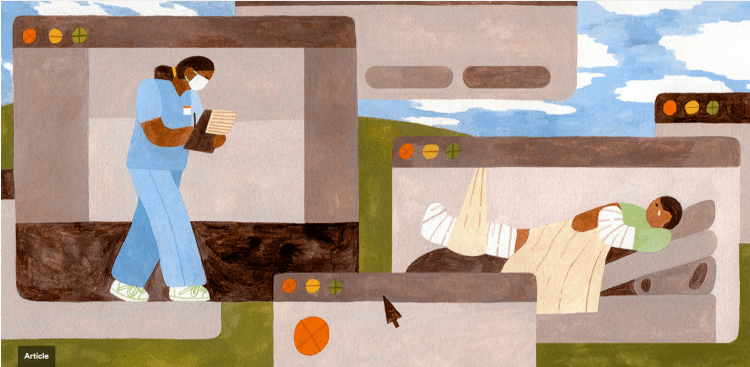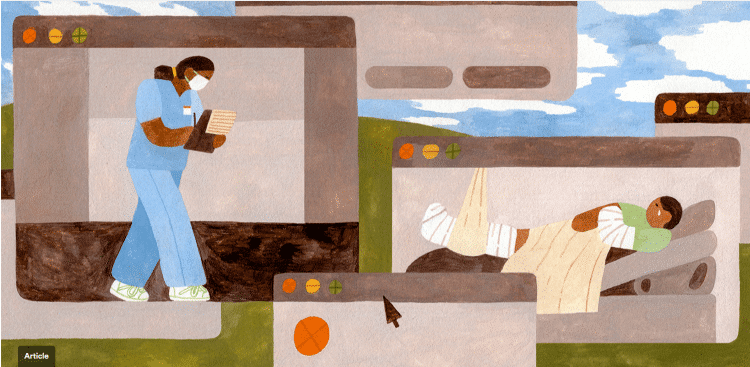Virtual simulation in nursing education: Balancing care for the ‘failing heart’ and the ‘breaking heart’
Article

This article was written in partnership with Healthy Debate, and is part of a series of seven articles that explore the relationship between technology and compassion in the field of health care today, and especially during the COVID-19 pandemic.
The sight of a blood-smeared basin filled with used medical instruments in front of drawn curtains made Ola Thomas Obewu, a nursing student at York University, wonder what had happened.
A clinical extern working in an emergency department, Thomas Obewu walked through the curtains and saw a woman lying on a bed who “just looked pitiful,” she recalls.
“Can you give me a brief, please?” the woman asked in a voice that was “so small,” Thomas Obewu remembers. “I felt like the voice had lost something.”
Puzzled, Thomas Obewu asked her if she also wanted to be cleaned. The woman said yes. When Thomas Obewu returned with a clean pair of briefs and began wiping the woman clean, Thomas Obewu realized that the woman had been lying in her own blood for about 30 minutes. Thomas Obewu began piecing together what had happened. She has just lost her baby, Thomas Obewu recalls thinking at the time. She is in so much pain but she is alone.
The woman thanked her repeatedly, Thomas Obewu recalls. “I just touched her hand … very soft and delicate,” she says. “It’s OK,” she told the woman.
As Thomas Obewu reflected on this encounter later that day, she was struck by how starkly it differed from an interaction with another patient who had also undergone an invasive procedure affecting the female reproductive system: a hysterectomy, the removal of the uterus. The main difference? The patient had been on Thomas Obewu’s computer screen and resembled a character from The Sims.
Thomas Obewu had been using vSim for Nursing, a program in which nursing students navigate avatars through scenarios meant to simulate realistic clinical situations. But Thomas Obewu had not found it realistic at all: she had only had the option of asking the virtual patient about her physical condition, while in reality, a nurse would likely also be comforting a newly infertile patient struggling to accept how the operation has changed her, Thomas Obewu says. For Thomas Obewu, the contrast between the compassionate clinical encounter and the brusque questioning on vSim exemplified the restrictiveness and sterility of vSim in general: “It doesn’t prepare you for anything.”
Thomas Obewu’s negative review of vSim taps into a larger debate over what the ideal role and scope of virtual-simulation learning modules should be in Canadian nursing education after the COVID-19 pandemic. Because the pandemic decreased the number of “clinical placements,” in which students practice nursing in a clinical setting, the use of virtual simulations in nursing schools has spiked. Now, some nursing professors are expressing concern that, after the pandemic, virtual simulations could encroach into the time reserved for clinical placements – especially as some administrators at nursing schools eye these simulations as possible alternatives to clinical placements, which are often hard to arrange. But other nursing professors argue that now is a perfect opportunity for scaling up a pedagogical tool that has been unfairly sidelined out of deference to the traditional clinical-apprenticeship model of nursing education. Striking the right balance between clinical placements and virtual simulations is not just important for ensuring that nursing students acquire the knowledge and technical skill set they’ll need; it is also a matter of ensuring that nursing students develop the profoundly human character traits at the heart of what it means to be a nurse.
Thomas Obewu was critical of vSim, but it is not the only kind of virtual-simulation learning module. Some use recordings of actors who play the roles of patients, their loved ones and other health-care workers. Recently, a handful of Canadian nursing schools rolled out immersive virtual reality, in which students don headsets that take them inside digital clinical environments, although most nursing students use virtual simulations on their computers. Many of these simulations work by introducing nursing students to scenarios through short animated or acted-out videos that are viewed from the vantage point of a working nurse. These videos provide nursing students with important information about the patient in the scenario. Students are then quizzed, often by a pop-up multiple-choice menu, on what they should do given the unique circumstances of the scenario. If they make the right choice, the simulation proceeds. If they make a mistake, they are prompted to try again. Students are given explanations about why their choices were correct or incorrect.
Proponents of the simulations say they give students a solid foundation of technical and theoretical knowledge, but more importantly, they develop higher-level cognitive skills. “The virtual simulation’s strength is that it really does develop those critical thinking and clinical judgment skills,” says Nicole Harder, an associate professor of nursing at the University of Manitoba and editor-in-chief of Clinical Simulation in Nursing. Her lab even uses virtual simulations to teach nursing students how to be more empathetic.
Clinical practice is essential to nursing education, Harder says, but she argues that many hours reserved for clinical placements should be replaced with virtual simulations. She noted that one 2014 study reported that replacing up to half of the hours spent in clinical placements with high-quality simulations “produces comparable end-of-program educational outcomes” and that, according to a systematic literature review published in March, there are no studies containing solid evidence that the clinical-apprenticeship model works, “rais(ing) serious questions about nursing education’s continued reliance on traditional clinical models,” according to the review. Still, many Canadian nursing schools have been reluctant to substitute clinical placements with virtual simulations to the extent she recommends. “Inherently, people don’t like change,” she says.
However, the pandemic could catalyze a lasting increase in the use of virtual simulations within nursing schools, Harder says. Suzanne Campbell, an associate professor of nursing at the University of British Columbia and expert in teaching with simulations, says that now is “an opportunity for moving into the 21st century.”
The desire to increase the use of virtual simulations is not always pedagogical in motivation, notes Bernie Garrett, an associate professor of nursing at UBC who recently gave a keynote presentation about the future of nursing education at a conference hosted by the Canadian Association of Schools of Nursing. Because of the long-standing difficulty in securing clinical placements for nursing students, “there is very strong pressure from university administrators and school of nursing administrators, particularly, to take students away from practice,” he says. “It’s very important to be cautious of quick-fix solutions.”
Some nursing professors have adopted this cautious attitude. “The simulation should augment and supplement, not replace (clinical practice),” says Claire Mallette, an associate professor of nursing at York University.
Virtual simulations are intrinsically more restrictive than a clinical environment, Mallette says. They cannot capture the “fluidity of human life,” concurs Michelle-Marie Spadoni, an associate professor of nursing at Lakehead University. Relying too heavily on them may deprive students of the fast-paced chaos that they must learn to roll with in clinical settings.
But Marian Luctkar-Flude, an associate professor of nursing at Queen’s University and co-president of the Canadian Alliance of Nurse Educators using Simulation, argues that virtual simulations “can scaffold that chaos” by introducing nursing students to it incrementally. “If they’re overwhelmed, they can’t learn,” she says.
The rigid parameters of a simulation are overly constraining in another way, Mallette and Spadoni argue. Because simulations tend to narrowly focus on a patient’s medical issues, overreliance on the simulations poses the risk that students will not acquire enough experience viewing patients from a holistic, as opposed to biomedical, standpoint. There are other kinds of suffering that are not physiological that nurses must tend to, Mallette says: “vSim can’t capture looking at the person as a whole, and looking not only at the failing heart, but the breaking heart as well.”
Alleviating this sort of suffering gets at the core of what it is to be a nurse, the professors say. Small acts of compassion – such as encouraging a woman to hold her dying mother’s hand and tell her everything she wants to, as Mallette once did – are referred to as “the little things,” Mallette says. “In actual fact, it’s knowing and recognizing at that human level what is most important to care for the people and meet their needs.”
This empathetic attentiveness cannot be learned through a simulation, Mallette argues. “Some students will do it because that’s who they are, but many will not, and there is the risk they will get almost robotic.”
Sometimes, alleviating suffering in this way requires accepting that someone cannot get better – which, naturally, falls outside the scope of most virtual simulations, in which nursing students must focus on “solving the game,” helping a patient recover, Mallette says. But nursing students will have to learn to strike a balance “between fixing things and celebrating the imperfections and making them as strong as possible,” she says.
“That is the beauty of human life,” Spadoni adds. “It’s imperfect. It has raw edges. It’s got sharp points. It has wounds.”

Related
Seniors with dementia in LTC homes are using virtual reality to relive their pasts
Caregivers and researchers hope that LTC residents who visit lifelike simulations of meaningful places from their pasts will recall old memories not yet motheaten by dementia, causing them to feel a sense of wistful joy, a swell of pride and to open up to others.
Saying Goodbye on FaceTime
Participating in that call was “gut-wrenching,” Shaikh said, but she realized that to maintain the emotional stamina she would need to make it through the pandemic, she would “have to change (her) perspective.”
Could AI make health care more human?
CHARTwatch, is a tool that uses artificial intelligence (AI) to continuously monitor the medical status of patients on Saint Michael’s General Internal Medicine unit.
